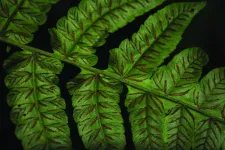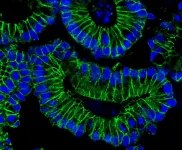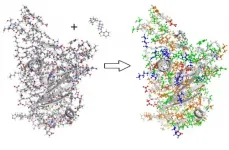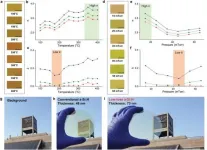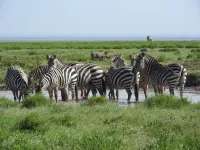(Press-News.org) Earth is home to millions of known species of plants and animals, but by no means are they distributed evenly. For instance, rainforests cover less than 2 percent of Earth's total surface, yet they are home to 50 percent of Earth's species. Oceans account for 71 percent of Earth's total surface but contain only 15 percent of Earth's species. What drives this uneven distribution of species on Earth is a major question for scientists.
In a paper published February 16 in the Journal of Biogeography an international team of researchers led by Jacob S. Suissa, Ph.D. Candidate in the Department of Organismic and Evolutionary Biology, Harvard University, and co-authors Michael A. Sundue, University of Vermont, Burlington, and Weston L. Testo, University of Gothenburg, Sweden, assembled the first global assessment of fern diversity. The study integrated digitized herbarium data, genetic data, and climatic data to determine where most fern species occur and why.
The researchers relied on recently digitized natural history collections to map the diversity of life on earth and build a database of over one million fern specimens with longitude and latitude coordinates occurring all over the world. After an extensive cleaning of the database to remove records with poor coordinates roughly 800,000 occurrence records remained. They then divided the earth into one-degree latitude by longitude grid cells and determined the number of species occurring within each cell. The researchers discovered that the majority of fern species occur in eight principally montane hotspots: Greater Antilles, Mesoamerica, tropical Andes, Guianas, Southeastern Brazil, Madagascar, Malesia and East Asia.
"Natural history collections are the primary data for all biodiversity studies, and they are the backbone to this study," said Sundue. "Scientists have been making collections and curating them for hundreds of years. But only recently, the digitization of these records has allowed us to harness their collective power."
Testo agreed, "There has been a large effort over the last decade to digitize the impressive collection of specimens contributed by thousands of collectors and experts in the field and deposited in museums or natural history collections. For this study we used over 800,000 digitized occurrence records for nearly 8,000 fern species."
The research was conducted in multiple phases and each phase built upon the previous. "The first thing we wanted to know is where are the centers of ferns' biodiversity, and second, why?" Suissa said. "We wanted to understand the biogeographical patterns of fern diversity. Understanding these patterns in a major plant lineage like ferns, allows us to take a step towards understanding why there is an uneven distribution of species around the world."
One major finding is that 58 percent of fern species occur in eight principally montane biodiversity hotspots that comprise only 7 percent of Earth's land area. They also found that within these hotspots, patterns of heightened diversity were amplified at elevations greater than 1000 meters above sea level.
"On a global scale we find a peak in species richness per area around 2000 to 3000 meters in elevation, roughly midway up some of these tropical mountains," explained Suissa. "And we think this is primarily due to a very unique ecosystem that occurs in this elevation band, which in the tropics is the cloud forest."
While ferns grow in a variety of ecosystems, including moist shaded forest understories and rocky desert outcrops, many species are actually epiphytic, meaning they grow on the branches of trees. Suissa and colleagues believe these epiphytes explain the mid to upper elevation peak in species richness of ferns in the tropics.
Once the researchers determined the biogeographical patterns of fern diversity, they investigated why these particular patterns exist. Examining ecological data, including climate and soil data, they showed that within each hotspot there was a strong correlation between increased climatic space and increased species richness and diversification; suggesting that ferns occurring in tropical mountains are forming new species more rapidly than those elsewhere.
"People tend to think of places such as the Amazon rainforest as biodiversity hotspots," said Suissa. "But for ferns, it is tropical and subtropical mountains that harbor a disproportionate number of rapidly diversifying species relative to the land area they occupy. Ferns may be speciating within these tropical mountain systems because of the variation in habitats that occur across elevational gradients. For instance, at the base of a tropical mountain it is hot all year round, and at the summit it is perennially cold. Essentially, these dynamics create many different ecosystems within a small geographic space."
Unlike mountains in temperate regions, the tropics have very low temperature seasonality. This means that each ecosystem across an elevational transect in a tropical mountain remains roughly the same temperature year-round. Effectively, it is harder for plant and animal species to move between elevational zones if they are adapted to one spot on the mountain. Researchers think that these dynamics between the difference in climates at different elevations and the climatic stability within each elevational site allow for plants and animals to diversify more rapidly in tropical mountains.
Going forward the researchers hope to conduct more small-scale population-based studies in young tropical mountains to physically test these hypotheses, and to hopefully also add more specimens and continue to expand digitization of museum collections for study.
INFORMATION:
Article and author details
Jacob S. Suissa, Michael A. Sundue, Weston L. Testo. 2021. Mountains, Climate, and Niche Heterogeneity Explain Global Patterns of Fern Diversity. Journal of Biogeography DOI: 10.1111/(ISSN)1365-2699
Corresponding author
Jacob Suissa, jsuissa@g.harvard.edu
Memorial Sloan Kettering Cancer Center (MSK) physicians and scientists presented new research at the 2021 American Society of Clinical Oncology Genitourinary Cancers Symposium held virtually February 11-13. Notably, MSK medical oncologist Robert Motzer, MD, presented encouraging data from a phase III randomized study that assessed two new treatment combinations as first-line treatments that may prolong survival in people with advanced kidney cancer. Dr. Motzer's findings were also published on February 13 in the New England Journal of Medicine.
In this large, international trial involving 200 sites across 20 countries, Dr. Motzer and a team of investigators ...
Using advanced RNA sequencing, scientists have identified two unique subtypes of a prominent mutation present in many patients with Acute Myeloid Leukemia (AML) - called NPM1 - that could help predict survival and improve treatment response for patients whose leukemic cells bear the mutation.
In research published Feb. 16, in Nature Communications, a team led by Princess Margaret Cancer Centre Senior Scientists, Drs. Benjamin Haibe-Kains, Aaron Schimmer and Mark Minden, have discovered that within the NPM1 mutation of AML there exists two unique subtypes, one of which can be effectively treated with drugs already in use.
It is the first study to classify within the common NPM1 mutant form of AML two subtypes, one being "primitive" and the other ...
Most people infected with SARS-CoV-2 are able to recover from the disease at home - even if they might experience very stressful disease progressions. Some have no symptoms at all. But about ten percent of those affected become so severely ill that they have to be treated in a hospital. The assumption that a weak immune system is behind a severe progression is short-sighted. Especially with critical progressions, the immune system works under intense pressure, but does not manage to control the virus.
A Berlin research group has now observed how SARS-CoV-2 uses an immune system defense mechanism to increasingly hijack ...
Computing - Modeling COVID dynamics
To better understand the spread of SARS-CoV-2, the virus that causes COVID-19, Oak Ridge National Laboratory researchers have harnessed the power of supercomputers to accurately model the spike protein that binds the novel coronavirus to a human cell receptor.
These simulations also shed light on the ligand molecules that can inhibit such binding, pointing the way to potential drug therapies.
An ultrafast quantum chemical modeling method provides information about the critical electronic interactions between protein and ligand chemicals, going beyond the classical interaction models that are normally employed in computational drug discovery.
The findings will enable accurate predictions of the performance of currently available inhibitors ...
The University of Kent has led a study highlighting the urgent need for the UK's Government and renewable energy industries to give vital attention to decommissioning offshore wind turbines approaching their end of live expectancy by 2025. The research reveals that the UK must decommission approximately 300 and 1600 early-model offshore wind turbines by 2025 and 2030, respectively.
Urgent focus is needed now to proactively use the remaining years until turbines installed in the 1990s and early 2000s are no longer safely functional in 2025, to prevent safety lapses, potentially huge costs and the irretrievable loss of the skillset required for safe decommission.
The research shows that these original turbines have an approximate lifetime of 20 to 25 years, but this expectation ...
Atropisomers are a class of stereoisomers (chemical compounds that differ in spatial arrangement of atoms) arising from restricted rotation around a single bond and have various applications in chemistry. To date, most research on atropisomers has focused on "biaryl atropisomers" (due to the rotational restriction around a carbon-carbon bond), but it is also possible for atropisomers to arise from rotational restrictions around a nitrogen-carbon (N-C) bond. These N-C axially chiral compounds are found in various natural products and bioactive compounds and thus have promising applications in medicine ...
A POSTECH research team has developed a transparent amorphous silicon that transmits visible light - which permits us to distinguish the colors of objects - enabling the development of paper-thin lenses usable in head-mounted displays (HMD) that show virtual and augmented reality images in real time.
A research team - led by Professor Junsuk Rho of POSTECH's mechanical engineering and chemical engineering departments, and Ph.D. candidate Younghwan Yang and Dr. Gwanho Yoon of the Department of Mechanical Engineering - has developed visibly transparent amorphous silicon by improving the plasma enhanced chemical vapor deposition (PECVD) method, a practice widely used by Korean display manufacturers. ...
Tsukuba, Japan - Sleep is very important for athletes, and sleep loss can affect physical performance and cognitive ability. But now, researchers from the University of Tsukuba have identified the prevalence of sleep disorders in visually impaired athletes, as well as specific risk factors associated with lower sleep quality.
In a study published last November in Sleep Medicine, researchers from the University of Tsukuba conducted a survey of 99 visually impaired athletes in Japan and analyzed data from 81 respondents. They found that approximately one-third of the respondents had sleep disorders. Further, higher levels of stress regarding interpersonal relationships ...
CORVALLIS, Ore. - Statistical modeling developed by Oregon State University researchers has confirmed that changes to melanoma patients' gut microbiome led them to respond to a type of treatment capable of providing long-term benefit.
Findings were published in Science.
The modeling technique invented by Andrey Morgun of the OSU College of Pharmacy and Natalia Shulzenko of Oregon State's Carlson College of Veterinary Medicine is known as transkingdom network analysis.
The human gut microbiome is a community of more than 10 trillion microbial cells from about 1,000 different bacterial species, and transkingdom network analysis integrates ...
Water is a necessity for all life but its availability can be limited. In geographical areas experiencing dry seasons, animals congregate near the few freshwater sources, often reaching large densities. At these sites many animals from different species come to the same spots to drink, potentially operating as key locations for pathogen transmission within and between species. An international team of scientists lead by the German Leibniz Institute for Zoo and Wildlife Research (Leibniz-IZW) suggests that viruses can use restricted freshwater sources as a vector to be spread among animals. The key prediction of this idea is that animal viruses remain stable and infectious in water. The team ...
